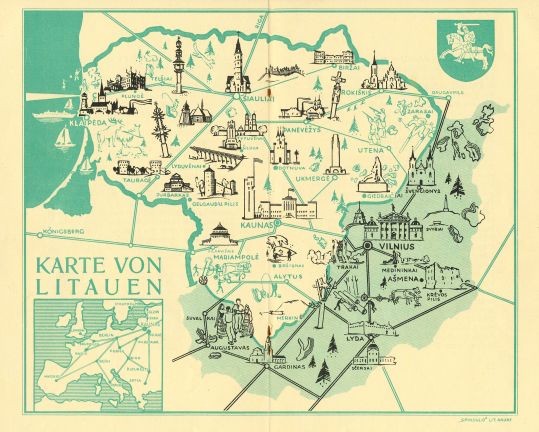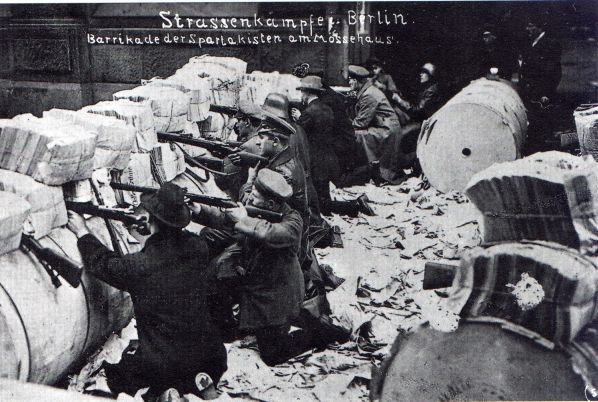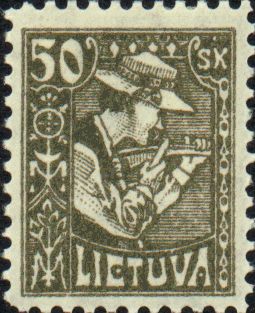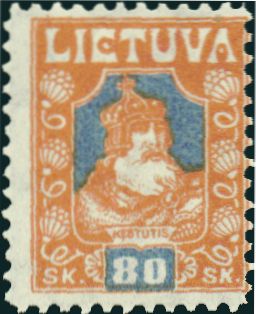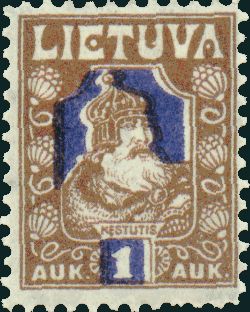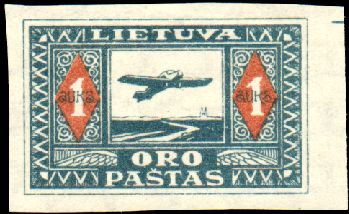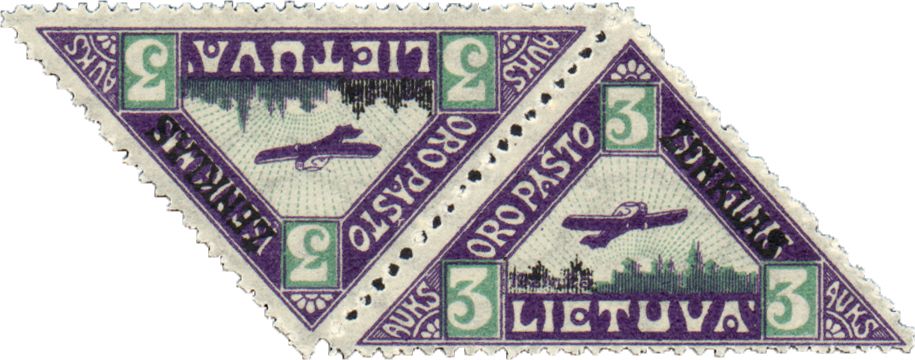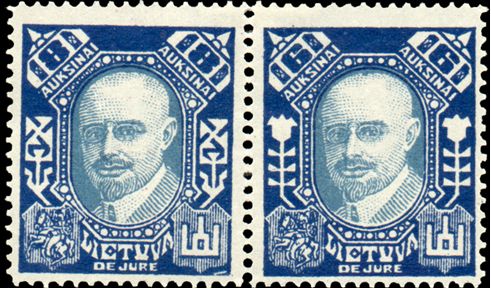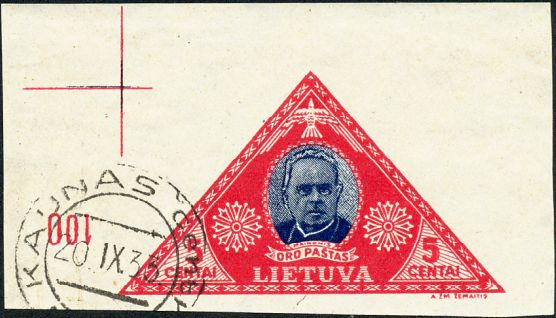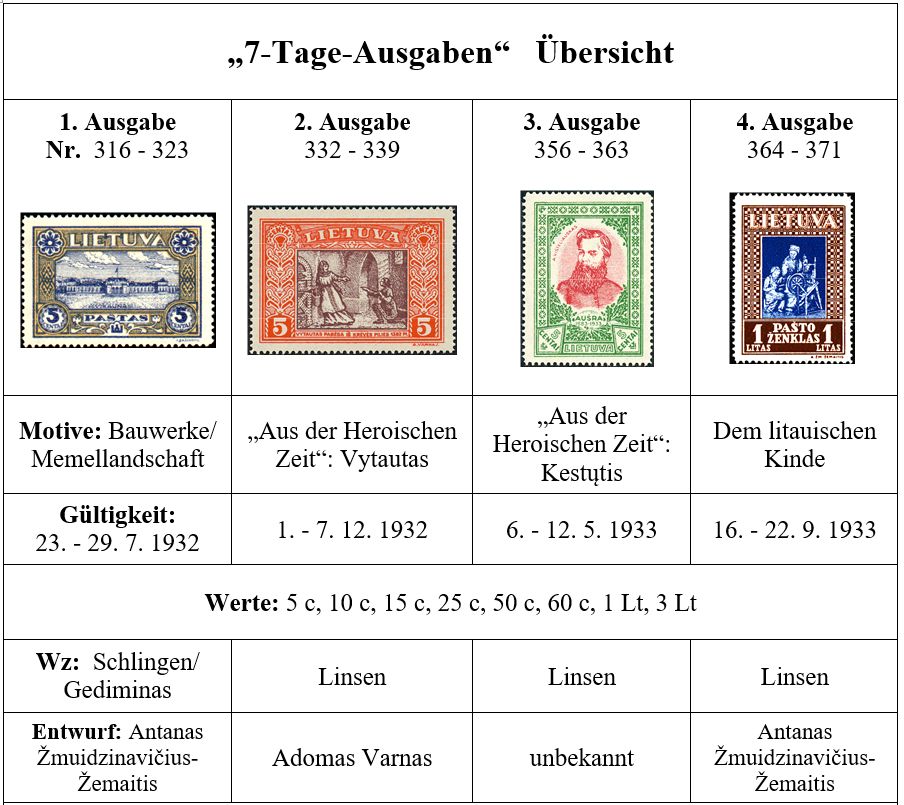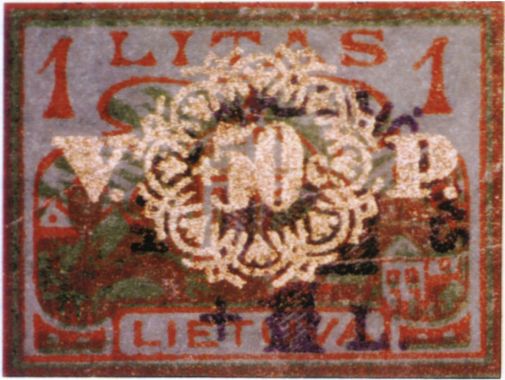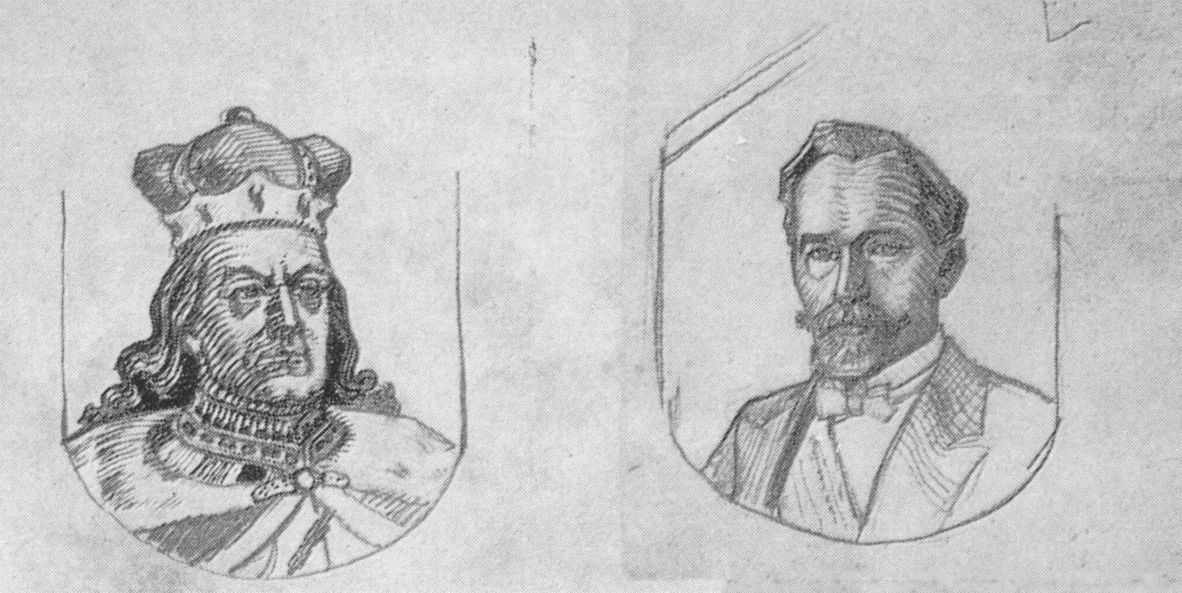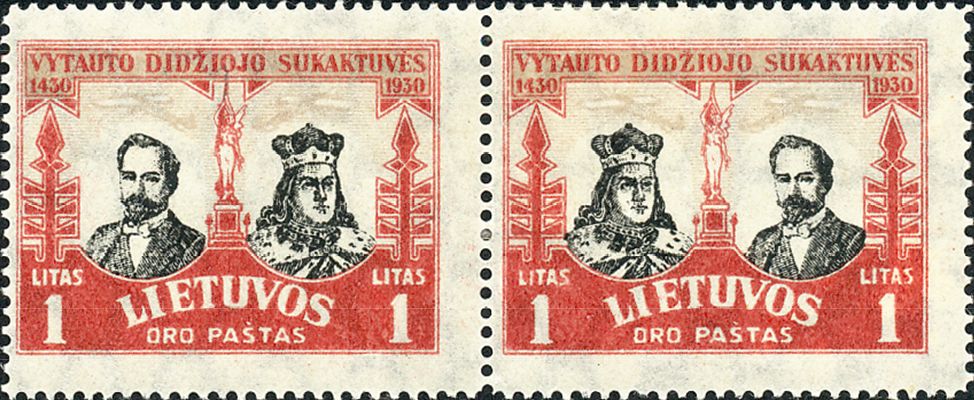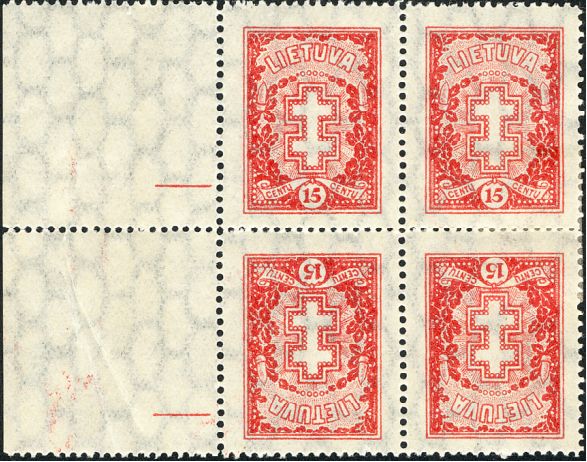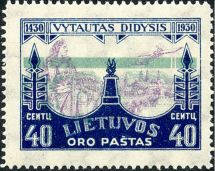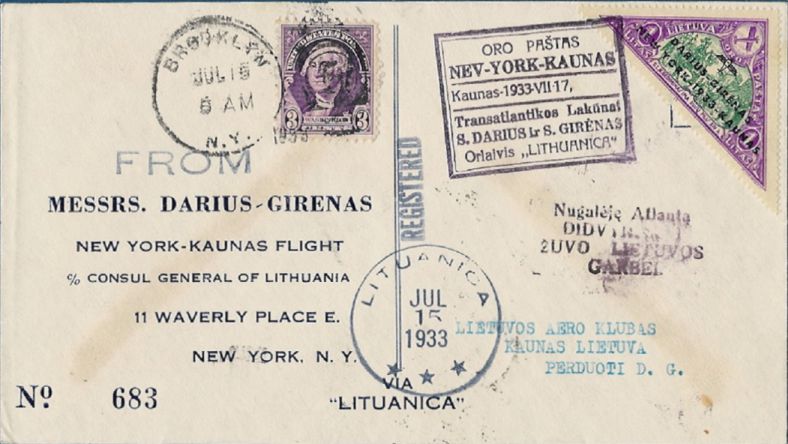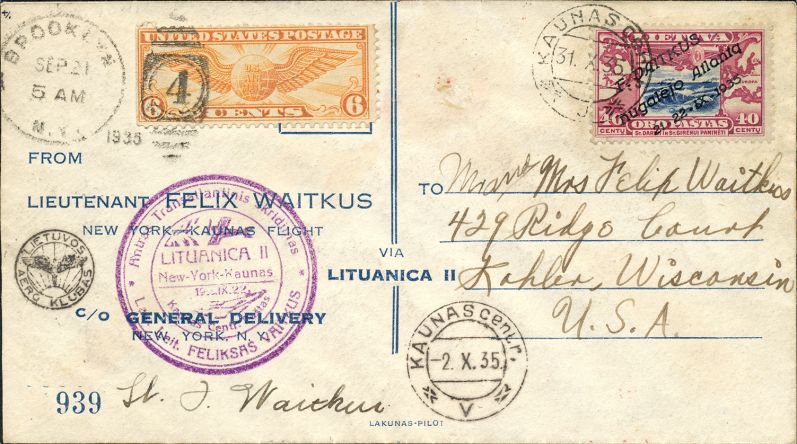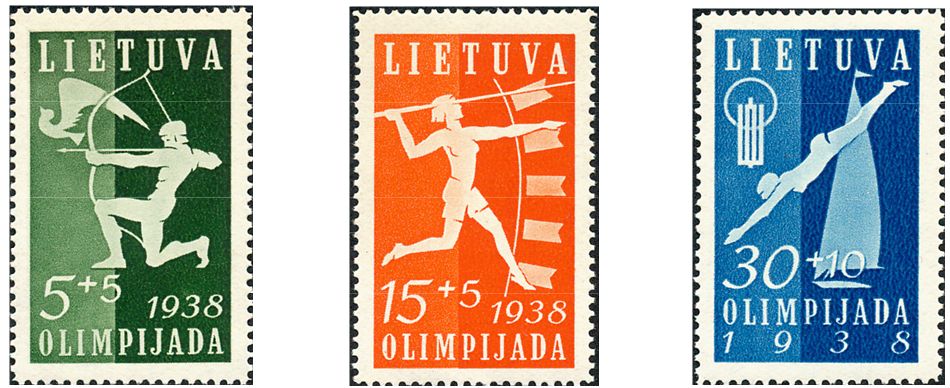Lithuania
-
Royal Polish Post
-
Imperial Russian Post
-
German Occupation / Ob. Ost
-
Independent Republic of Lithuania
Lithuania – here is the geographical centre of Europe, about 25 km north of the capital Vilnius. With a current area of 65,301 km² the country is larger than Denmark with 43,094 km², but has only 2.78 million inhabitants (2019). For a while, in the early modern period, Lithuania was the largest territorial state in Europe.
In the 14th century, the Lithuanians were the last people in Europe to convert to Roman Catholic Christianity and thus joined the Latin cultural sphere along with its writing. The Lithuanian language belongs to the Indo-European language group and is the oldest living language of this family in the world.
The independent Republic of Lithuania is one of the nations that emerged as a result of the First World War (1914–1918). The Lithuanians can look back on a long state tradition: first mentioned in documents as a country in 1009, until 1569 as an independent Grand Duchy and then in personal union with Poland. In 1775, the principality disappeared from the map with the third partition of Poland, and the Russians followed as the new masters. Their rule ended when German troops occupied the area in 1915 (see the chapter German Occupation 1915-1918).
The Auksinas Period (1918/19 to 1922)

Map of Lithuania 1922
(Source: The Times Atlas)The dashed border line shows how unclear the border lines were in Eastern Europe after the First World War. This was especially true for Lithuania.
While still under German occupation, Lithuania declared its independence on February 16, 1918. Today this date is the Lithuanian National Day. On November 11, 1918, the state constituted itself as a republic with democratic principles and free and secret elections.
In the liberation war that followed, they had to stand their ground against several opponents. On January 2, 1919, the Lithuanian government fled from Vilnius to Kaunas, which remained the provisional capital until 1939. Up until international recognition in 1922, the existence of the state as a whole, and even afterwards within its existing borders, remained disputed.

Counties in Lithuania 1935
(Source: Lietuvos Istorijos Atlasas 2001, p. 56)The coloured areas show Lithuania in the de facto borders of 1935. The blue-white shaded areas show the Vilnius region belonging to Poland (cf. explanations on Central Lithuania) as well as regions in the south around the cities of Grodno, Lida and Suwalki, which today partly belong to Lithuania, Belarus or Poland; Kaunas is named as the provisional capital.
During these three years until the end of 1918, the currency of the Lithuanian state initially consisted of the German "Ostmark", which was unceremoniously renamed Skatiku (=Pfennig, translated as "minted") and Auksinas (=Mark, "golden") in 1919, followed by the Litas from the end of 1922.
The Litas Period (1922-1940/41)
Only in the course of 1922 did the Lithuanian state find itself in a position to introduce its own gold-based currency with the help of Great Britain and the USA. On October 1, 1922, a Sunday, the new currency 1 litas = 100 cents was introduced. It was now pegged to the US dollar, with a fixed exchange rate of 10 litas = US$1, corresponding to 0.150462 grams of gold. Logistical problems made the changeover a lengthy, complicated operation. The population had to calculate in old auksinas or "Ostmarks" for a while until banknotes and coins of the new currency were available. Finally, stable monetary conditions were achieved.
Domestically, the period after 1922 was initially characterised by continuing uncertainties, even after international recognition. A coup in 1926 and the subsequent era of the authoritarian Smetona government brought economic recovery, but no political participation of broader sections of the population. Nevertheless, this period, and especially the person of Smetona, is seen in a mainly positive light today, as it stands for a time of assertion and consolidation of the Lithuanian state.
The recourse to Lithuania's former role as a great power in Europe as the state-bearing doctrine of the Smetona era collided with its real existence as a small state.

Mi No. 316
(1st airmail issue Lietuvos Vaiko) The stamp depicts a map of Lithuania with the claimed areas around Grodno, Suwalki, Lida and Vilnius.
This balancing act between great power aspirations and reality narrowed the scope for foreign policy more than in the case of the other two Baltic states. Lithuania's relationship with its neighbours Germany and Poland had been burdened by mutually exclusive territorial claims since its foundation in 1918. From Poland, Lithuania demanded the Vilnius area, Suwalki and Grodno, of which only Vilnius/Wilna/Wilno had any significant Lithuanian population. The occupation of Memel in January 1923 by Lithuanian irregular forces and its following annexation by Lithuania was subsequently recognised by the League of Nations, but was openly opposed by Germany since its withdrawal from the League of Nations in 1933.
It is a bitter irony of history that Lithuania lost its independence in 1940 to the power with which there had been no border problems since the Treaty of Moscow in 1920: the Soviet Union. After an ultimatum, Lithuania was occupied by the Red Army on June 14, 1940 and incorporated into the Soviet Union on August 3 of the same year.
Postal history
Auksinas currency 1918/19–1922
Vilnius and Kaunas issues
The Vilnius and Kaunas issues are an expression and result of the political situation of radical change after the end of World War I. They were created around the turn of the year 1918/19, when the Lithuanian Post operated just 10 post offices.

Vilnius and Kaunas issues, Selection from Mi No. 1–26
f.l.t.r.: 1. Vinius issue with lean value digits, 2. Vilnius issue with fat value digits, 1. Kaunas issue "skatikų", 2. Kaunas issue "sk.", 3. Kaunas issue "sk. X sk."
Very popular is the plating of this total of 26 stamps, most of which had been printed in sheets of 20.
Berlin issues
The Vilnius and Kaunas issues were not suitable for mass use, neither in terms of print run nor design. Representative stamps were needed. The Berlin printing company H. S. Hermann, which had no experience with stamp printing but produced ration cards and tram tickets, produced a total of four series of so-called Berlin issues in the period February to May 1919, the first three of them as template issues on different papers and watermarks.
Printing was a difficult undertaking, as at the time of the printing order in January 1919 the Spartacus uprising took place in Berlin and there was a great shortage of paper (cf. also the detailed article by Martin Bechstedt on the Berlin issues in the Lituania No. 22 (2004).

Proof Berlin issues
Strip of five with 50 sk. – 5 auks. cut, printed contiguously in red or red/black; proof in the design of the later issue.
By the beginning of 1919, 93 post offices were again operating on Lithuanian territory. The Lithuanian postal administration immediately sent highly motivated employees to every area that had just been won in the war of liberation, so that by the end of 1922 the number of operating post offices was already 196. Until the currency reform on October 1, 1922, few series appeared, which are summarised as stamps of the Auksinas period.
Most important are the definitive series called "Sower Mower" and the "De Jure" commemorative issue as well as four airmail series.
Permanent series: Sower-Mower-Kestutis issue
According to the large number of stamps and editions printed, numerous colour and paper variants exist. Besides the sower and the mower, the third motif is the portrait of the Lithuanian Grand Duke Kestutis, who ruled from 1345 to 1382.
Airmail series
Most of the airmail issues did not find their actual destination, but were postmarked to please on set letters or transported by land. Very few of them have seen an aircraft "from the inside".
De jure edition
The occasion for the De Jure issue of 1922 was the recognition of Lithuania as a state under international law ("de jure") by the League of Nations.
These large-format stamps consisted of partially unneeded values and were intended to pay tribute to persons from Lithuania's contemporary history. As they appeared three days before the currency reform, their validity was limited to only a few days.
With the marginal cliché of the 8 Auksinas stamp in the printed sheet of the 6 Auksinas stamp, which does not belong here, a spectacular variety resulted:
Litas currency 1922–1940/41
For the currency reform, stamps of the Auksinas currency were overprinted with the new currency indications in Litas and Cent. This was done in a hurry, resulting in a "mammoth set" full of variations.

Strip of overprint specimens in black, enclosed with Circular No. 217/29709 of the Postal Directorate of 9 November 1922 and sent to post offices to combat counterfeiting. (Illustration from PHILLIT No.50 (2009) p.9)
There was no fixed ratio between the old auksinas and the new litas denomination; only the overprint value in the new currency was decisive for the post office. Mainly the stamps of the 4th Berlin issue and the Sower / Mower series were overprinted, but also a small number of values of the 2nd Berlin issue, whereby it cannot be excluded that rarities were intentionally created here.
The Sruoga–Affair
Philatelically, the machinations of Adolfas Sruoga dominated the years up to 1935.
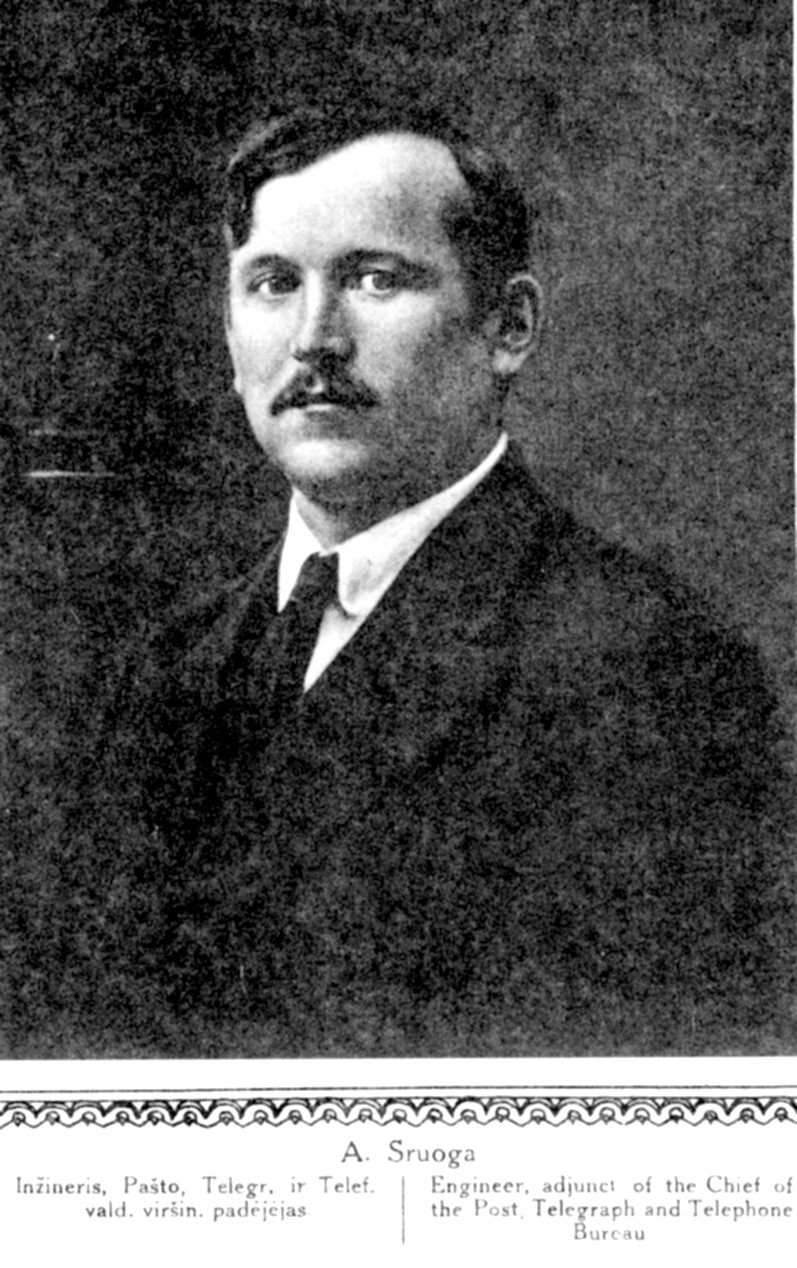
Adolfas Sruoga (Source: Wikipedia)
The Director General of Posts and Telecommunications was responsible for an excessive issuing policy with many varieties, speculative items such as the "7-day issues" and ( temporally overlapping) "mammoth series".
He influenced the printing of stamps, initiated the creation of "varieties" and managed money into his own pocket, bypassing the postal administration.
Click on the following topics for more detailed information.
The Margolinas and Andrejevas printing houses had been replaced in 1925 by the newly established State Printing House, which was transformed into a state-owned joint-stock company in 1928, now under the name "Spindulys". In spite of this, the printed products did not meet expectations for a long time.
At a time when Estonia was pursuing the most serious issuing policy, a contemporary compared his country's stamps to the quality of "beer labels" (so the doctor and philatelist Jonas Mikulskis from Teliai in an acrimonious article of 1932).
Prof. Adomas Varnas, the most important designer of Lithuanian stamps at the time, repeatedly pointed out the outdated technology and the inferior printing results.
The quality of the stamps was also adversely affected by the long insistence – until 1938 – on technically outdated lithography, so that even ambitious designs suffered from the technical realisation.
He was also responsible for the unprecedented "7-day issues": Sruoga secured large revenues through an agreement with the Ukrainian-born New York stamp dealer Lissiuk, in which it was agreed that the latter would cover the production costs, but the Lithuanian Post Office would ensure the legality of the stamps. In order to pretend that the stamps were legal, it was decided that they would only be valid for one week, hence the name, and that only whole sets could be sold at the counter, completely indisputable conditions for a state stamp issue! Lissiuk had already offered the same procedure to other states, but was "rebuffed" and only had moderate success in Latvia: the so-called fund stamps were pure speculative issues and a pain in the neck.
At the beginning of the 1930s, Sruoga had obviously overstepped the mark: The spectacular misprint of the Vytautas airmail series of 1930 with the "swapped heads" caused quite a commotion because of the respectless use of state symbols: on the 1 litas stamp, the portraits of Vytautas the Great and President Smetona had been swapped on two fields of the left corner of the sheet! The postal administration subsequently received angry letters from collectors in Paneveys who had tried to get this "misprint" at the post office counter but only saw sheets with the corners torn out. The stamps in question had been cut out before distribution and sold expensively by Sruoga and his accomplices via the route already described.
Slowly, the ball started rolling and triggered a veritable avalanche: In the autumn of 1932, the public prosecutor's office received an anonymous tip about Sruoga's criminal machinations. The ensuing in-depth investigation involving the famous artist and stamp designer Prof. Adomas Varnas brought much more to light: the numerous varieties, many more than were usual in the issues of other states, had essentially been initiated directly by Sruoga and printed at Margolinas. Sruoga was then able to take the varieties out of the magazine as he had already done and sell them through the post office and various dealers.
The court records of the trial speak of a profit of an incredible 2,860,500 litas from these machinations, an unimaginable fortune at the time.
Only for the production of forgeries and the exchange of the stamps could Sruoga be legally prosecuted, but not for the initialisation of the varieties and speculative issues. Varnas followed a court deal and certified the 3 Lt - and 5 Lt - stamps mentioned at the beginning as forgeries with different paper and perforation (which was not true), which had not been printed at Margolinas (which was also not true). Since Margolinas had also printed regular stamps with an official postal order, Sruoga would not have been prosecuted for forgery of stamps.
After long negotiations, the criminal case of stamps was concluded on February 26, 1935. Suspended in May 1933, Sruoga was sentenced to 15 years in prison, the postmaster of Klaipeda, J. Augunas, to 5 years; other accomplices received prison sentences of several years, the postal inspector V. Varanka committed suicide (he had already helped with the Mariampolė issue, i.e. reprints of the Kaunas issues in 1919). There were still some revisions in which sentences were reduced or cancelled. Sruoga's fortune was confiscated, the reprinted values were shipped to the court archives or the Criminal Police Museum, and the ex-postmaster's stamp collection with a franking value of 0.5 million litas was auctioned off. Sruoga himself suffered a cruel fate: he died in a German concentration camp at the time of the occupation of Lithuania.
After the conclusion of the court case, the Lithuanian Post's issuing policy returned to normal.
Today, varieties caused by sruoga for profit are regarded as "sruoginiai" (term of M. Pavilionis):
No. 94 I (80 sk.) and No. 95 I (1 a.): different colours of the centre pieces, double print on No. 95 I (without illustration)
No. 270 Y: 5 c double cross with mint parquet (without ill.)
No. 313: 1 Lt with switched heads; the variety that brought Sruoga down (no ill.)
Possibly even more varieties were the result of manipulations. In addition, Sruoga subsequently sanctioned the legality of the differently coloured stamps of the 1920 National Assembly series (Mi Nos. 78 I - 83 I) for an according fee.
Air letters
The most popular Lithuanian philatelic products, however, are not due to Sruoga. The Darius Girėnas and Feliksas Waitkus stamps and letters were intended to finance spectacular Atlantic flights.
The most expensive pieces of Lithuanian philately are not stamps at all, but vignettes without franking value; these triangular overprint stamps owe their existence to the initiative of the Lithuanian Consul General Povilas adeikis in New York and a dealer there.
The last years of independence
After Sruoga's unmasking in 1933 and his subsequent conviction, Lithuania's issuing policy from 1934 onwards was more serious than before. The quality of the stamps increased significantly and the number of varieties decreased. The postal administration drew the consequences from the limited printing possibilities in the country and awarded prestigious items such as the Darius Girėnas issue 1934 and the anniversary set for Smetona's 60th birthday to the British printer Bradbury Wilkinson & Co. from New Malden.
It was possible to double the number of operating post offices from 340 in 1925 to 691 in 1940. Thanks to the solid litas currency, postage rates remained stable for a long time; for an international postcard they were even reduced from 36 to 35 cents on 1.7. 1934 (but only because no more stamps were printed for the "buckled" postage). From 1.1.1923 to December 1940 there were only three postage periods!
Between 1936 and 1940, Spindulys delivered several more permanent and special editions, now managing to switch from the outdated lithographic printing to the more modern halftone gravure. The "sports issues" in particular became popular:
-
Central Lithuania
-
Memel Area / Klaipėda
-
Soviet Occupation
-
German Occupation / Ostland
-
Camp Mail / Lithuanians in Exile
-
Independent Republic of Lithuania (restored)
-
Private Mail in Lithuania


